 Wow, so it was October that we last posted to this blog…..fear not however, the winemaking has been going strong and we look forward to starting our next run soon, but more on that later! If you recall at the end of our last post we had just pitched the yeast to put the Auslese Riesling into Primary Fermentation and our winemaking friends in Lenox had crushed their season’s run and also started the primary on that beautiful red as well. A lot has gone on since then…….we’ve bottled the Riesling and started an icewine style Cabernet Franc and bottled that too! Our friend Matt joined me in Lenox to press Clyde’s fermented grapes with his wife and sister-in-law. OK, enough blabbing, here’s the good stuff with descriptions where pertinent!
Wow, so it was October that we last posted to this blog…..fear not however, the winemaking has been going strong and we look forward to starting our next run soon, but more on that later! If you recall at the end of our last post we had just pitched the yeast to put the Auslese Riesling into Primary Fermentation and our winemaking friends in Lenox had crushed their season’s run and also started the primary on that beautiful red as well. A lot has gone on since then…….we’ve bottled the Riesling and started an icewine style Cabernet Franc and bottled that too! Our friend Matt joined me in Lenox to press Clyde’s fermented grapes with his wife and sister-in-law. OK, enough blabbing, here’s the good stuff with descriptions where pertinent!
First thing is first, what HAVE we been doing? Well the holidays were one thing….which was another great opportunity to try our Malbec.
One of my (Kevin) other hobbies is amateur astronomy…..and I’m also an amateur telescope maker. The other project that took center stage for a while was to finish a telescope I had been building for my friend and fellow amateur astronomer Steve. We had been into the project for a bit more than a year and wanted to be done for him to enjoy it during the Spring months. We finished it this past week! If that type of project interests you, the pictures from the entire build are here.
OK, so here we go…..

These are the stabilizing and fining agents that will take care of any remaining yeast and clear the wine. The large packet on the right contains a flavor reserve that will help give the fully fermented wine it’s off-dry sweetness.

All ingredients and fining agents added, ready for clearing stage. We also added our glass marbles to top up the carboy.

Riesling after about a week of clearing. You can see it is progressing quite nicely. Notice the sediment on the marbles at the bottom as it drops out of suspension.
While the Riesling was clearing, my friend Matt and I had the opportunity to visit Clyde, his wife Irene, and sister-in-law Ana in Lenox for his pressing! This is the batch mentioned in our previous post that Clyde sent pictures of them crushing after bringing his grapes up from his supplier in Brooklyn.
Matt’s day of playing wine maker wasn’t quite over, we selected him to help start our Cabernet Franc Icewine Style wine. It is called an Icewine “Style” because while it tastes very much like an icewine, it is not made the same way. The differentiation was made in part to discourage wine makers from developing and selling wine this was as true Icewine. As you can imagine the “style” process is much less involved and much less expensive. From experience I can tell you that these Icewine Style kits come VERY close to the real thing, but the real thing still has its own discernible difference of course…….and true Icewines are WELL worth their cost and are a very unique wine. So what is Icewine anyway? To make Icewine the wineries leave the grapes on the vines well into the freeze/thaw cycle. This process essentially concentrates the sugars in the grapes making the juice very, very sweet. At a time determined by the experience of the winery’s vintner, they are harvested and the winemaking process begun like any other. The end result is a wine that is extremely sweet….sweet enough it could be a dessert in and of itself. There are many ways people consume Icewine…..drizzled in ice cream or pound cake, or in the glass by itself. Either way, it’s richness lends to relatively small amounts being consumed at a sitting. As such, Icewine is often bottled in 375 ml bottles, half the normal size. This of course was a very basic description, you can read in more detail about Icewine here.
So, what is an Icewine Style kit? For this kit a Cabernet Franc wine kit is fermented as usual to produce a dry Cabernet Franc. Just before the clearing stage a Flavor Reserve Pack, high in sweetness is added to return the sugars to the wine that were removed during fermentation. The end result is an extremely sweet Icewine-like (style) wine…..and again, they are very close, and to some, imperceptible from the real thing; just made a different way.

After pitching the yeast, the Cabernet Franc Icewine style heads into primary fermentation on the wine making table next to the still clarifying Riesling.

It’s Riesling bottling day! On this table is all the bottling equipment from the racking cane to Buon Vino filter, bottle tree, and sanitizer.

Back to the Icewine…..here we rack the wine off the sediment in the Primary Fermenter to our 3 gallon Better Bottle carboy for the secondary fermentation.

Hydrometer reading confirms fermentation is complete. The wine is now dry and has an Alcohol by Volume of about 12%
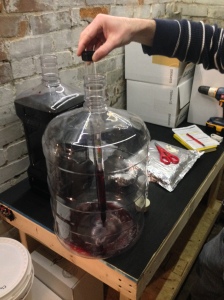
Racking the wine off the last sediment into a larger 6 gallon better bottle to make degassing and the addition of stabilizers and clarifiers easier.

Wine ready for the clearing stage. At this point the Flavor Reserve Pack, used to return the sugars to the wine that the fermentation removed.
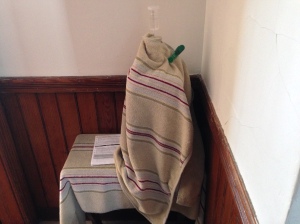
Clearing was to occur during a VERY cold month in our basement….so the carboy was moved upstairs and wrapped to keep light out for the next 22 days.
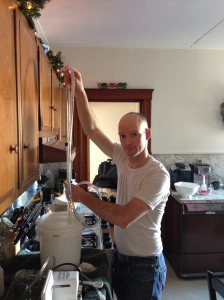
Kevin cleans equipment for bottling. We will rack via the Buon Vino filter system from the small 3 gallon carboy to the larger 6 gallon carboy for bottling.
So that’s a lot of wine we have now….both ours and those we’ve purchased. For Christmas this year we put a large capacity wine rack on our list. My parents came through with this nice 144 bottle rack which is now down in our winery and beginning to fill!
For Christmas they also gave us a nice sign for the winery that they had designed and made!
So what’s next? We are in the midst of ordering our next wine, a Washington Merlot…….and will follow that with a special, crisp summer wine. Stay tuned!










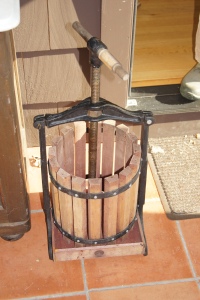





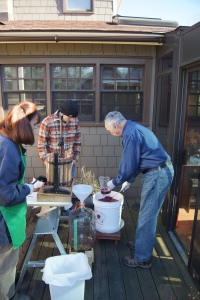



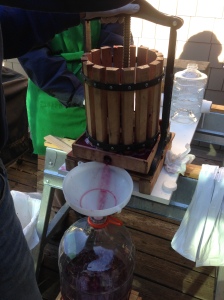


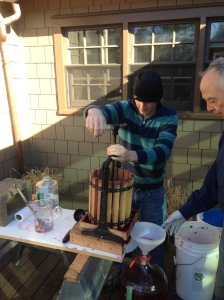
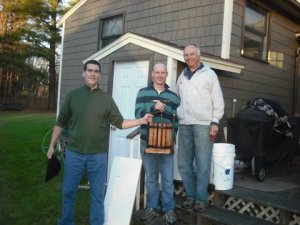







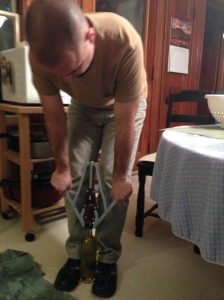
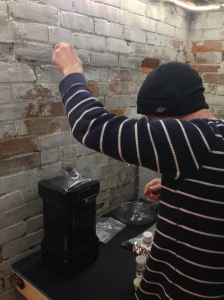


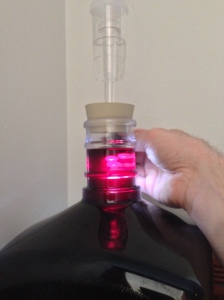





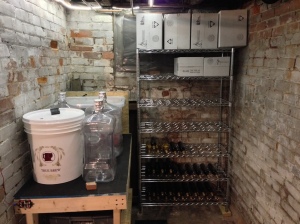

this covers a lot of territory since last posting Clyde